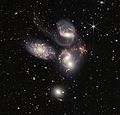Pegasus (constellation) facts for kids
| Constellation | |

List of stars in Pegasus
|
|
| Abbreviation | Peg |
|---|---|
| Genitive | Pegasi |
| Pronunciation | genitive |
| Symbolism | the Winged Horse / Pegasus |
| Right ascension | 21h 12.6m to 00h 14.6m |
| Declination | +2.33° to +36.61° |
| Quadrant | NQ4 |
| Area | 1121 sq. deg. (7th) |
| Main stars | 9, 17 |
| Bayer/Flamsteed stars |
88 |
| Stars with planets | 12 |
| Stars brighter than 3.00m | 5 |
| Stars within 10.00 pc (32.62 ly) | 3 |
| Brightest star | ε Peg (Enif) (2.38m) |
| Messier objects | 1 |
| Meteor showers | July Pegasids |
| Bordering constellations |
Andromeda Lacerta Cygnus Vulpecula Delphinus Equuleus Aquarius Pisces |
| Visible at latitudes between +90° and −60°. Best visible at 21:00 (9 p.m.) during the month of October. |
|
Pegasus is a large and famous constellation in the northern sky. It is named after the amazing winged horse, Pegasus, from ancient Greek mythology. This constellation was first listed by a Greek astronomer named Ptolemy way back in the 2nd century. Today, it is still one of the 88 constellations that astronomers officially recognize.
Pegasus is easy to spot because of its bright stars. The brightest star in Pegasus is called Epsilon Pegasi, also known as Enif. It's an orange supergiant star that marks the horse's muzzle. Three other bright stars, Alpha (Markab), Beta (Scheat), and Gamma (Algenib), team up with a star from the Andromeda constellation, Alpha Andromedae (Alpheratz), to form a cool shape called the Square of Pegasus. This square is a great way to find the constellation in the night sky!
Astronomers have found that at least 12 star systems in Pegasus have exoplanets. An exoplanet is a planet that orbits a star other than our Sun. One of the most exciting discoveries was 51 Pegasi, which was the very first Sun-like star found to have a planet orbiting it. This discovery changed how we look for planets outside our solar system!
Contents
Finding Pegasus in the Sky
Pegasus is a large constellation, ranking as the 7th largest in the sky. It is best seen in the Northern Hemisphere during the autumn months, especially in October. You can look for the "Square of Pegasus" to help you find it. This square is a very noticeable pattern of four bright stars.
The Stars of Pegasus
The stars in Pegasus help us imagine the shape of a winged horse.
- Enif (Epsilon Pegasi): This is the brightest star in Pegasus. It's a huge orange star that marks the horse's nose or muzzle.
- Markab (Alpha Pegasi): This star is part of the famous "Square of Pegasus." It marks one of the corners of the square.
- Scheat (Beta Pegasi): Another star in the "Square of Pegasus," Scheat is a red giant star.
- Algenib (Gamma Pegasi): The third star in Pegasus that forms part of the square.
These stars, along with Alpheratz from Andromeda, create the easily recognizable square shape that helps stargazers find Pegasus.
Deep Sky Objects in Pegasus
Besides its bright stars, Pegasus is home to some amazing deep-sky objects. These are objects far beyond our solar system, like galaxies and star clusters.
Stephan's Quintet
One of the most famous deep-sky objects in Pegasus is Stephan's Quintet. This is a group of five galaxies that are very close to each other. Four of these galaxies are actually interacting, meaning their gravity is pulling on each other, causing them to change shape. It's a fantastic sight for powerful telescopes. The James Webb Space Telescope has taken incredible pictures of Stephan's Quintet, showing it in amazing detail.
Images for kids
-
Pegasus with the foal Equuleus next to it, as depicted in Urania's Mirror, a set of constellation cards published in London c.1825. The horses appear upside-down in relation to the constellations around them.
-
Stephan's Quintet photographed by the James Webb Space Telescope.
See also
 In Spanish: Pegaso (constelación) para niños
In Spanish: Pegaso (constelación) para niños




